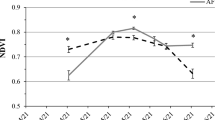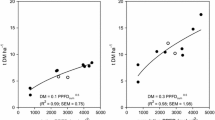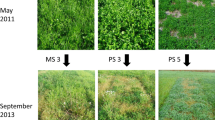Abstract
Tall fescue (Schedonorus arundinaceus [Schreb.] Dumort.) is genetically variable for many agronomic traits, so it might be possible to increase its persistence and productivity in shaded agroforestry applications. The objective of this research was to identify high yielding, shade-tolerant genotypes. Seed was obtained from eight families: seven plant introductions of European origin: 234718, 234720, 234882, 234884, 235018, 235019, 235036, and one cultivar (Kentucky 31). Two sequential experiments were conducted to select genotypes for dry mass yield during April–September. Experiment 1 included 30 genotypes of each of the eight families randomly assigned to each of two microenvironments: artificially shaded with fabric and unshaded. Maximum and minimum yields were 93.9 and 47.1 g family−1 for Kentucky 31 and 235036, respectively. After 1 year in Experiment 1, there were more survivors in the unshaded than shaded environment (0.40 and 0.09, respectively), ranging from 0 to 0.56 (235036 and Kentucky 31, respectively). Forty robust genotypes from four families (234718, 234720, 235019, and Kentucky 31) were selected from shaded and unshaded microenvironments of Experiment 1, clonally propagated, and evaluated in pots for 2 year in Experiment 2. Shade-selected Kentucky 31 yielded more (31.0 g plant−1) in shade than other shade-selected families (25.2–25.8 g plant−1). Eleven genotypes in the top quartile (yield ≥33.0 g plant−1) were selected for further testing. All genotypes were endophyte (Neotyphodium coenophialum Morgan-Jones and Gams)-infected. Further testing is needed to measure heritability of yield in shaded, water-deficit conditions of a tree understory.

Similar content being viewed by others
References
Belesky DP, Burner DM, Ruckle JM (2008) Does endophyte influence resource acquisition and allocation in defoliated tall fescue as a function of microsite conditions? Environ Exp Bot 63:368–377
Beuselinck PR, Vasquez RM, Frakes RV, Chilcote DO (1983) Cytological examinations of two tall fescue genotypes and their sterile hybrids. Crop Sci 23:485–487
Burner DM (2003) Influence of alley crop environment on orchardgrass and tall fescue herbage. Agron J 95:1163–1171
Burner DM, Belesky DP (2008) Relative effects of irrigation and intense shade on productivity of alley-cropped tall fescue herbage. Agrofor Syst 73:127–139
Burner DM, MacKown CT (2005) Herbage nitrogen recovery in a meadow and loblolly pine alley. Crop Sci 45:1817–1825
Burner DM, MacKown CT (2006) Nitrogen effects on herbage nitrogen use and nutritive value in a meadow and loblolly pine alley. Crop Sci 46:1149–1155
Burner DM, Balasko JA, Thayne WV (1983) Genetic and environmental variance of water soluble carbohydrate concentration, yield, and disease in tall fescue. Crop Sci 23:760–763
Burner DM, Balasko JA, O’Brien PM (1988) Attributes of tall fescue germplasm of diverse geographic origin. Crop Sci 28:459–462
Ciavarella TA, Simpson RJ, Dove H, Leury BJ, Sims IM (2006) Diurnal changes in the concentration of water-soluble carbohydrates in Phalaris aquatica L. pasture in spring, and the effect of short-term shading. Aust J Agric Res 51:749–756
Cookson SJ, Granier C (2006) A dynamic analysis of the shade-induced plasticity in Arabidopsis thaliana rosette leaf development reveals new components of the shade-adaptive response. Ann Bot 97:443–452
Gwinn KD, Shepard-Collins MH, Reddick BB (1991) Tissue print-immunoblot: an accurate method for the detection of Acremonium coenophialum in tall fescue. Phytopathology 81:747–748
Malinowski DP, Belesky DP, Lewis GC (2005) Abiotic stresses in endophytic grasses. In: Roberts CA, West CP, Spiers DE (eds) Neotyphodium in cool-season grasses. Blackwell, Ames, Iowa, pp 187–199
Morris K (2008) NTEP No. 08-1. Progress report national turfgrass evaluation program. Beltsville Agric. Res. Center-West. Bldg. 003, Room 218. Beltsville, Maryland 20705. On-line version http://www.ntep.org/data/tf06/tf06_08-1/tf06_08-1.pdf. Accessed 7 Nov 2008
Norton MR, Volaire F, Leli èvre F (2006) Summer dormancy in Festuca arundinacea Schreb.: the influence of season of sowing and a simulated mid-summer storm on two contrasting cultivars. Aust J Agric Res 57:1267–1277
Robson MJ, Jewiss OR (1968a) A comparison of British and North African varieties of tall fescue (Festuca arundinacea). II. Growth during winter and survival at low temperatures. J Appl Ecol 5:179–190
Robson MJ, Jewiss OR (1968b) A comparison of British and North African varieties of tall fescue (Festuca arundinacea). III. Effects of light, temperature and day length on relative growth rate and its components. J Appl Ecol 5:191–204
SAS Institute (2002) SAS/STAT user’s guide. Release 9.1. Windows version 5.1.2600. SAS Inst, Cary, North Carolina
USDA, ARS, National Genetic Resources Program (2006) Germplasm Resources Information Network—(GRIN). [Online Database] National Germplasm Resources Laboratory, Beltsville, Maryland. Available: http://www.ars-grin.gov/npgs/acc/acc_queries.html
Wahl S, Ryser P, Edwards PJ (2001) Phenotypic plasticity of grass root anatomy in response to light intensity and nutrient supply. Ann Bot 88:1071–1078
Zhai T, Mohtar RH, Gillespie AR, von Kiparski GR, Johnson KD, Neary M (2006) Modeling forage growth in a Midwest USA silvopastoral system. Agrofor Syst 67:243–257
Acknowledgments
The research was supported in part through a specific cooperative agreement (58-6227-8-0042) between USDA-ARS and University of Arkansas (Fayetteville). The authors appreciate the technical assistance of Jim Whiley and Karen Chapman (USDA-ARS, Booneville, AR), and Claudia Guerber (University of Arkansas, Fayetteville). Brad Venuto and Zeng-yu Wang gave helpful reviews of the manuscript. Mention of trade names or commercial products in this article is solely for the purpose of providing specific information and does not imply recommendation or endorsement by the U.S. Department of Agriculture.
Author information
Authors and Affiliations
Corresponding author
Rights and permissions
About this article
Cite this article
Burner, D.M., West, C.P. Improving tall fescue shade tolerance: identifying candidate genotypes. Agroforest Syst 79, 39–45 (2010). https://doi.org/10.1007/s10457-009-9274-2
Received:
Accepted:
Published:
Issue Date:
DOI: https://doi.org/10.1007/s10457-009-9274-2




